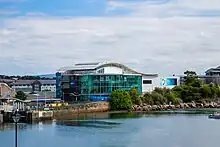National Marine Aquarium, Plymouth
The National Marine Aquarium, which opened in May 1998, is situated in Britain's Ocean City of Plymouth. It is the largest aquarium in the UK,[3] home to over 5,000 animals. It acts as an educational institution by teaching visitors about the marine environment.[3] The National Marine Aquarium is run by the Ocean Conservation Trust, a charity dedicated to ocean conservation.[3]
| National Marine Aquarium, Plymouth | |
|---|---|
 Entrance to the National Marine Aquarium | |
| 50.3666°N 4.1313°W | |
| Date opened | 1998[1] |
| Location | Plymouth, England |
| No. of animals | 5,000 |
| No. of species | 400 |
| Volume of largest tank | 2,500,000 L (660,000 US gal) |
| Memberships | BIAZA[2] |
| Major exhibits | 4 main zones |
| Website | www |
The marine aquarium is located in Sutton Harbour next to the Barbican and fish market. It is a member of the British and Irish Association of Zoos and Aquariums (BIAZA).
Exhibits
The Aquarium is divided into four main zones: Plymouth Sound, British Coasts, Atlantic Ocean and Blue Planet.
Plymouth Sound
This zone displays a variety of marine life found in Plymouth Sound. There are 17 tanks, which are home to approximately 80 species of fish and invertebrates, including local sharks, rays, and octopus.
Eddystone Reef
The second exhibit is the largest native offering in Britain, housing life-size models of whales and dolphins located around Britain. The large Eddystone tank displays an array of creatures found on the Eddystone reef, a reef 19km south of Plymouth. Visitors can see conger eels, mullet (fish), pollack, bream, and smooth hound sharks swimming in the open water; flatfish and rays hiding on the seabed; and lobsters and crabs hiding in the rocks.
Atlantic Ocean
This zone contains the 'Ocean Drifters' jellyfish exhibit and the largest tank in the aquarium. The 'Ocean Drifters' exhibit was opened in 2009, and includes; moon jellies, Japanese sea nettles, and upside-down jellyfish, housed in round tanks to prevent damage to their delicate bodies. The largest tank of the aquarium, houses 1,000 Caribbean fish, including; nurse shark, lemon shark, sand tiger shark, zebra shark, sandbar shark, barracuda, southern stingray, tarpon and turtle. The tank volume is 2.5 million litres. This exhibit was updated at the end of 2009, with the largest ever shipment of live fish into the UK, from Barbados, West Indies. It was updated again in 2015/16, with the addition of lemon and sand tiger sharks.
Blue Planet
This zone includes 'Biozone' and the 'Great Barrier Reef'. Biozone showcases the biodiversity found in the world's oceans and displays species such as; the longhorn cowfish, lionfish, giant Pacific octopus (Enteroctopus dofleini) and seahorses. This zone also includes the second largest tank at 700,000 litres, home to over 70 species of fish.
Conservation
The National Marine Aquarium led a project to sink frigate HMS Scylla in 2004 to create an artificial reef in Whitsand Bay, Cornwall.[4]
References
- "National Marine Aquarium". historyofplymouth.co.uk. Plymouth Places. Archived from the original on 17 August 2011. Retrieved 22 February 2011.
- "BIAZA Zoos and Aquariums". biaza.org.uk. BIAZA. Retrieved 21 February 2011.
- "About the National Marine Aquarium | The UK's Largest Aquarium". National Marine Aquarium. Retrieved 22 March 2022.
- wrecktoreef Web site:Artifical reef has generated millions for the Cornish economy, 7 April 2014
External links
 Media related to National Marine Aquarium at Wikimedia Commons
Media related to National Marine Aquarium at Wikimedia Commons- Official website